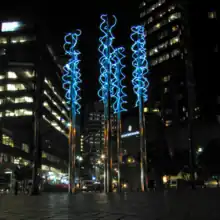
William Franklin Culbert MNZM (23 January 1935 – 28 March 2019) was a New Zealand artist, notable for his use of light in painting, photography, sculpture and installation work, as well as his use of found and recycled materials.[1]
He was born in Port Chalmers, near Dunedin, and divided his time between London, Croagnes in southern France, and New Zealand. He was married to artist Pip Culbert (1938–2016) and made many collaborative works with artist Ralph Hotere.
Early life and education
Culbert was educated at Hutt Valley High School, where his teachers included James Coe.[2] He then studied at the Ilam School of Fine Arts at Canterbury University College in Christchurch from 1953 to 1956, alongside Pat Hanly, Gil Taverner, Quentin McFarlane, Trevor Moffitt, Ted Bracey, John Coley and Hamish Keith, many who lived in the same house in Armagh Street.[3] Culbert received a National Art Gallery scholarship in 1957 and left New Zealand to study painting at the Royal College of Art, London.[3] He exhibited in the Young Contemporaries and Young Commonwealth Artists exhibitions alongside fellow expatriate New Zealander Billy Apple.
Career
Culbert began to experiment with electric light in 1967. He had a solo exhibition at the Serpentine Gallery, London, in 1977. The touring survey exhibition Lightworks was organised by City Gallery Wellington in 1997. He participated in the first Auckland Triennial in 2001. In 2013 he represented New Zealand at the 55th Venice Biennale. His exhibition, titled Front Door Out Back, was displayed in the New Zealand pavilion, sited at the Istituto Santa Maria della Pietà.
He has permanent commissioned sculptures in London, Wellington and Auckland. Many are collaborative works with Ralph Hotere, including Fault on the facade of City Gallery Wellington (1994), Void (2006) in the atrium of Museum of New Zealand Te Papa Tongarewa and Black Stump, a 20m-high column outside the Vero Centre in Auckland.[3][4] His work is held in public and private collections throughout New Zealand and Europe.
Culbert died on 28 March 2019.[5]
Awards, honours and fellowships
- National Art Gallery Scholarship (New Zealand), 1957
- Artist in Residence, University of Nottingham, 1963–65
- Greater London Arts Association Award, 1981
- Arts Council of Great Britain Holographic Bursary, Goldsmiths' Holography Workshop, Goldsmiths' College, London, 1982
- Residency, Museum of Holography, New York, 1985
- Residency, Exploratorium, San Francisco, 1989
- Member of the New Zealand Order of Merit, for services to art, particularly sculpture, 2008
References
- ↑ Clifford, Andrew (12 April 2006). "Culbert finds light in other people's throwouts". New Zealand Herald. Retrieved 2 April 2013.
- ↑ Johnston, Courtney (23 October 2013). "A morning with Bill Culbert". Dowse Art Museum. Retrieved 16 October 2021.
- 1 2 3 Moore, Christopher (6 May 2013). "International artist seeks Chch roots". The Press. Retrieved 7 May 2013.
- ↑ Farrar and Tamati-Quennell, Sarah and Megan (25 February 2013). "Ralph Hotere, 1931-2013". Te Papa Blog. Museum of New Zealand Te Papa Tongarewa. Retrieved 7 May 2013.
- ↑ Manson, Bess (6 April 2019). "Bill Culbert, the master of light, dies aged 84". Stuff.co.nz. Retrieved 9 April 2019.
Further reading
- Ian Wedde, Making Light Work (Auckland: Auckland University Press, 2009) ISBN 9781869404390
- Justin Paton, Light Wine Things (Dunedin: Dunedin Public Art Gallery, 2005) ISBN 9780908910441
- Lara Strongman (ed.) Lightworks (Wellington: City Gallery Wellington, 1997) ISBN 0958355452
- Christopher Moore , Lighting the way with art, in Stuff, 20 October 2011
- John Daly-Peoples, The lightness of Bill Culbert, in National Business Review, 27 November 2009
- David Eggleton, The lightness of being Bill Culbert, in The landfall review online, 1 June 2011
- Gregory O'Brien, The Light Fantastic, in New Zealand Listener, 15 August 2009